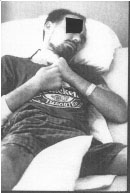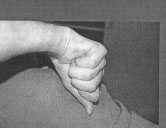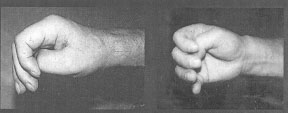| 1. The Adducted/Internally Rotated Shoulder
กล้ามเนื้อมัดที่มีการเกร็งตัวได้แก่ latissimus dorsi, teres major, clavicular head และ sternal head ของ pectoralis major, |
 |
| 2. The Flexed Elbow
กล้ามเนื้อมัดที่มีการเกร็งตัวได้แก่ biceps, brachialis, brachioradialis โดย brachioradialis จะเกร็งมากกว่าอีก 2 มัด -ในรายที่เกร็งไม่มากจะมีการเกร็งของข้อศอกงอขึ้น เมื่อผู้ป่วย ยืนหรือเดิน ทำให้ทำกิจวัตรต่าง ๆ ลำบาก - ในรายที่เกร็งมากจะเกิดแผลที่ผิวหนังบริเวณ antecubital fossa ทำความสะอาดบริเวณนี้ยาก |
 |
| 3. The Pronated Forearm
มีการเกร็งตัวของกล้ามเนื้อ pronator teres และ pronator quadratus Twitchell พบว่ากล้ามเนื้อที่ฟื้นกลับช้าที่สุดในผู้ป่วย CVA คือ supinator |
 |
| 4. The Flexed Wrist
กล้ามเนื้อมัดที่มีการหดเกร็ง ได้แก่ Flexor Carpi Radialis (FCR), Flexor Carpi Ulnaris (FCU), Flexor Digitorum Sublimis (FDS), Flexor Digitorum Profundus (FDP) Severe Spastic Wrist Flexion ทำให้เกิดWrist Subluxation และ Carpal tunnel syndrome ได้ |
 |
| 5. The Clenched Fist
กล้ามเนื้อมัดที่มีการหดเกร็งได้แก่ FDS และ FDP ถ้า distal interphalangeal (DIP) joint เหยียด แสดงว่ามีการหดเกร็งของ FDS มากกว่า FDP นิ้วทุกนิ้วจะกำอยู่ในฝ่ามือ บางรายมีเล็บจิกเข้าไปในผิวหนังด้าน ฝ่ามือ มีแผลเรื้อรังที่ฝ่ามือ ทำความสะอาดยาก |
 |
